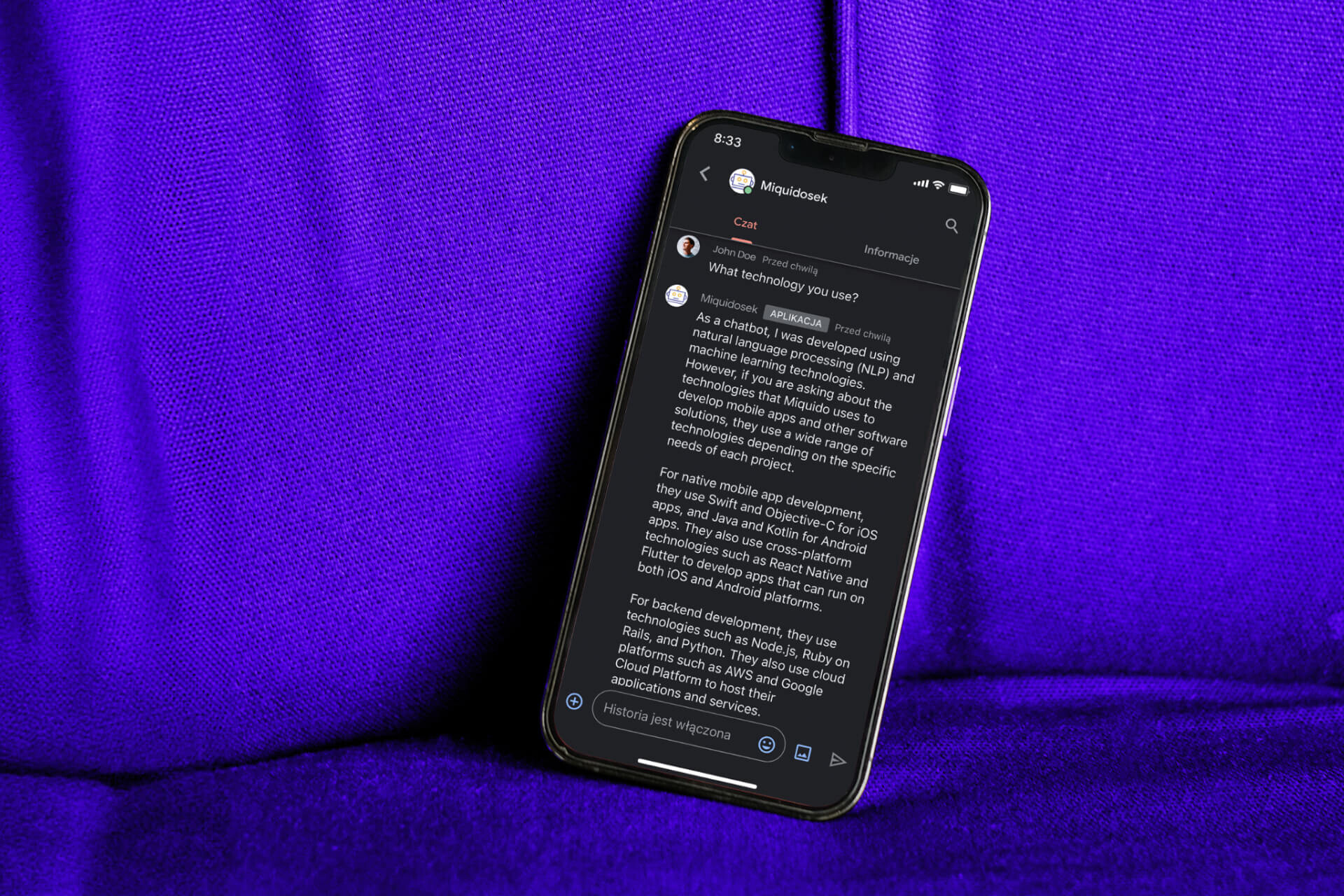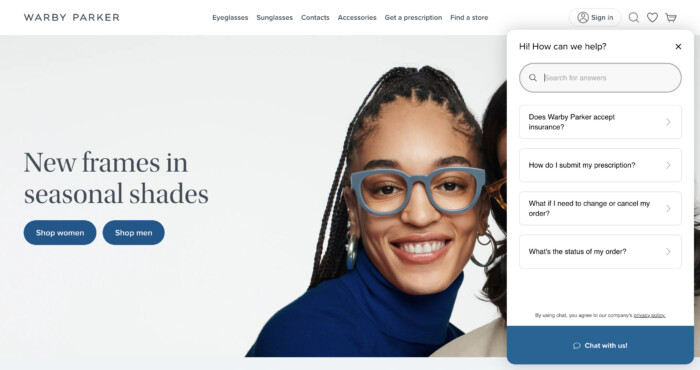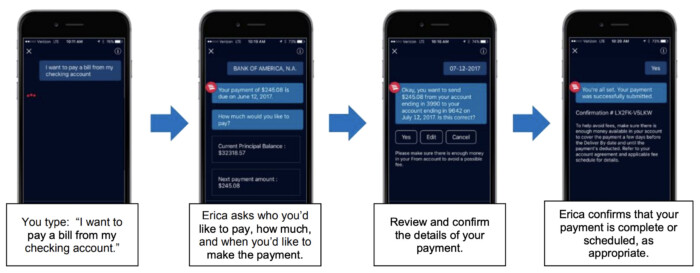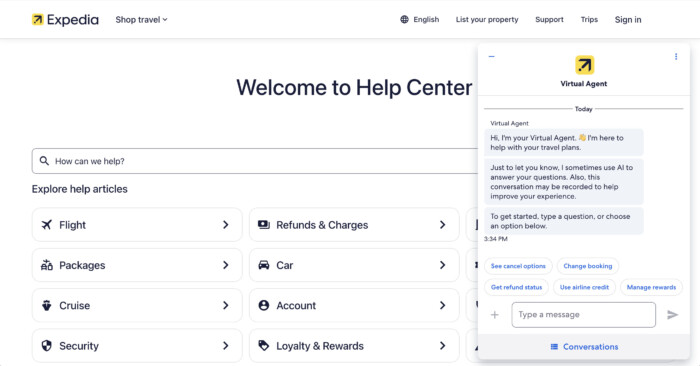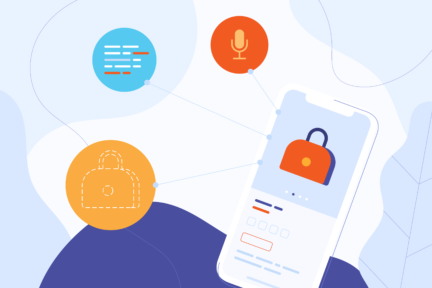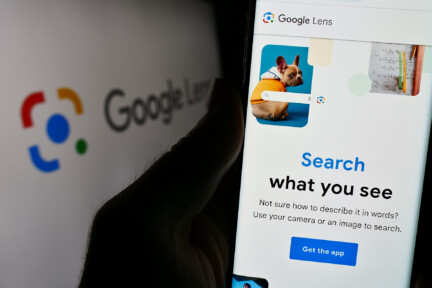According to a CCW market report, about 84% of business owners believe AI chatbots will become more important for customer communication.
Not only that, but AI chatbots can also streamline internal processes to improve efficiency and overall organizational performance.
This post covers everything you need to know about AI chatbots, answering key questions like “What are AI chatbots?” and “How do AI chatbots work?” You’ll also learn how to use AI chatbots to improve your business operations.
But first…
What are AI chatbots?
AI chatbots are computer programs that simulate human conversations. They interact with users through text or voice and are designed to mimic real-life dialogue.
How do chatbots work?
The AI chatbot architecture relies on artificial intelligence (AI), specifically machine learning (ML) and natural language processing (NLP).
Machine learning enables chatbots to learn from a series of interactions and improve over time. NLP helps chatbots understand, interpret, and generate human language.
So, when a user inputs a query or prompt, the chatbot is triggered to understand what the user needs. Then, scan through a database to deliver the most relevant responses.
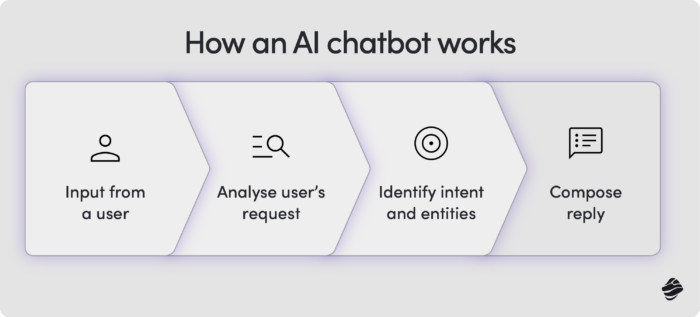
Artificial intelligence chatbots are among the top AI trends in mobile apps and web development. These bots are more like virtual assistants capable of handling repetitive tasks related to customer engagement, internal communications, and other key aspects of business operations.
What are the main types of chatbots?
Chatbots can be placed into several groups based on the technology they use.
Rule-based chatbots
A rule-based chatbot follows pre-determined rules and can only respond to specific inputs based on its training data. So, if a user inputs any question outside of the rules, the bot won’t understand or provide a correct response.
Rule-based chatbots are the simplest types. They’re typically used for specific tasks like answering FAQs or booking appointments.
AI-powered chatbots
AI-powered chatbots use machine learning algorithms and NLP to understand more complex inputs. They can analyze users’ requests, adapt to new situations, and provide more accurate answers.
For instance, GPT-3 by OpenAI is a notable AI that can process human language. Chatbots integrated with GPT-3 can use deep learning to provide human-like responses to text-based and even voice queries.
Unlike the rule-based bot, AI-powered bots can handle longer or more detailed conversations. These bots can quickly determine a user’s intent and improve through repeated conversations.
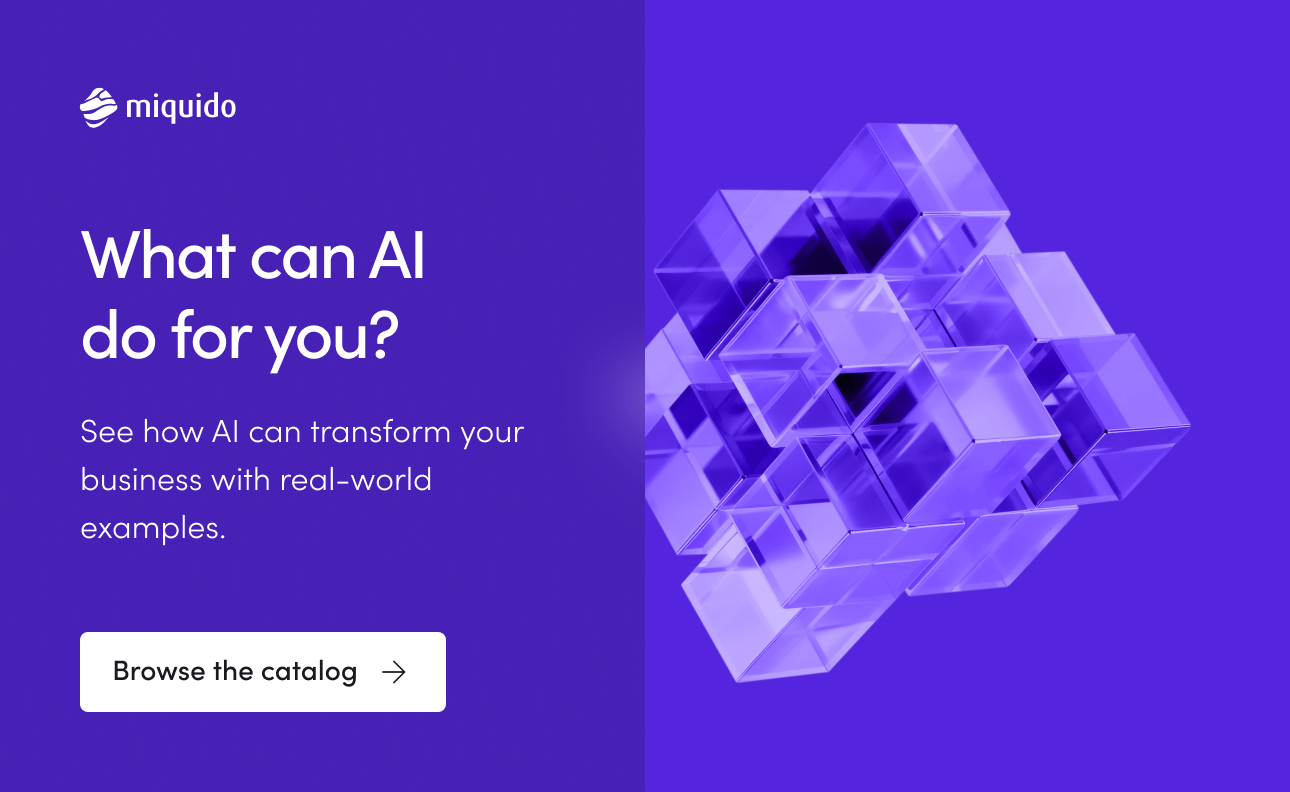
Hybrid chatbots
Hybrid chatbots combine rule-based systems with AI. This allows them to handle structured data with predefined rules and learn from more complex user inputs.
Since hybrids can handle both repetitive user queries with predefined keywords and more complicated human conversations, businesses can enjoy a good level of flexibility.
Voice-activated chatbots
Voice-activated chatbots respond to spoken commands. They use speech recognition to convert voice into text, which AI then processes to generate appropriate responses.
These chatbots are widely used as personal assistants, especially with smart devices. Alexa and Siri are good examples.
Benefits of AI chatbots
Artificial intelligence chatbots can benefit your business in various ways, including:
Faster response times
According to a survey by MIT Technology Review, about 90% of businesses report tangible improvements in the speed of complaint resolution using AI.
AI Chatbots can operate around the clock, responding instantly to customer service inquiries. This improves customer satisfaction by eliminating wait times.
Reduced operational costs
A HubSpot survey reveals that 35% of marketers, 54% of bloggers, and 41% of business leaders use AI chatbots to improve their workflow.
Automating tasks like answering FAQs or handling simple queries frees up leaders and employees for more complex tasks.
HubSpot also reports that 71% of customer support specialists agree that AI can help them improve the entire customer experience.
With customer service, automated chatbots can be set up to handle complaints and inquiries, reducing the workload on human agents.
Scalability for customer support
Conversational AI chatbot solutions can use NLP to process user queries. This reduces the need for human intervention when responding to user requests.
These chatbots can handle large volumes of inquiries simultaneously. They pull responses from vast datasets, making them ideal for managing spikes in customer demand. A human agent will only step in on complicated issues that require human input.
Improving customer service
Chatbots can gather information on customer preferences or attributes through real-time interactions. For instance, some chatbots are configured to collect customer email addresses at the start of conversations— which is good for lead generation.
The information from your chatbots can be used to analyze customer behavior and improve customer service (for example, by providing tailored responses to the most common issues).
Analyzing human behavior can also give you insights into customer journeys and preferences. This allows you to optimize your marketing strategies for optimal results.
Personalized customer experiences
One of the best things about AI chatbots is that they can tailor responses based on user preferences or past conversations. This leads to more personalized and engaging customer experiences.
For instance, the chatbot might recommend specific products or resources based on past customer interactions or purchasing patterns.
Some chatbots can also understand the emotional context of human conversations by assessing things like tone or word choices. This allows them to almost empathize with the user and provide more personalized responses for their unique scenarios.
Challenges of AI chatbots
You will face several challenges when introducing AI chatbots into your workflows. Here are some of the most common ones and how to address them:
Initial setup costs and complexity
Implementing an AI chatbot requires a significant upfront investment in technology and resources. Companies can spend thousands of dollars to build a simple AI chatbot.
Let’s briefly assess how much it may cost to build an AI chatbot:
- The initial research alone may cost about $5,000 – $50,000.
- The development process may cost approximately $5,000 – $10,000
- Integration can add up to $8,000 – $10,000.
You must also factor in additional costs (roughly $200 – $2,000) if you acquire data to train the chatbot. Then there are maintenance costs, which tend to be between 15% and 20% of the development cost.
Do you see how the costs can quickly add up?
Thankfully, solutions like AI Kickstarter are making developing customized chatbots easier and more affordable.
AI Kickstarter is an AI framework that helps businesses build reliable, smart, and scalable apps three times faster than starting from scratch. With AI Kickstarter, companies can save up to 80% on development costs and 40% on operational costs.
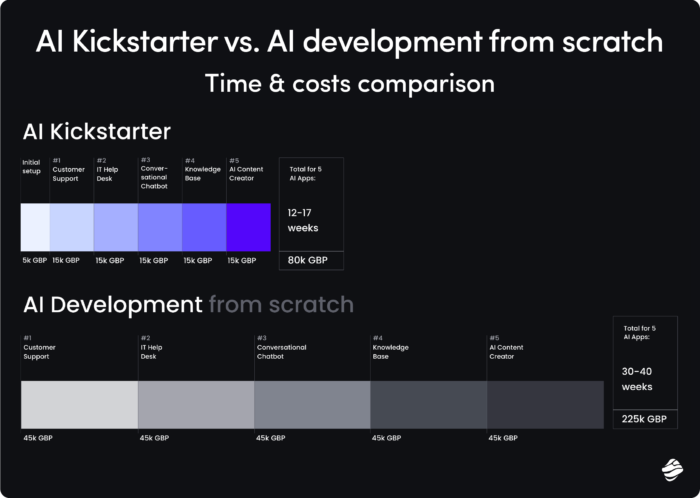
There’s a sharp difference in the costs of AI chatbots built with AI Kickstarter and those without. For instance, where a customer support chatbot costs $45,000, AI Kickstarter can cut this cost to $15,000.
Book a free consultation with our experts to learn how AI Kickstarter can deliver a cost-effective AI chatbot tailored to your business.
Limitations in complex customer queries
While AI chatbots are improving, they still struggle with highly complex questions.
Still, systems like AI Kickstarter use techniques like retrieval-augmented generation (RAG) to mitigate these challenges. With RAG, AI chatbots use your unique data to generate relevant and more accurate responses. AI Kickstarter also supports all types of SLMs (small language models) and LLMs (large language models).That means chatbots built with AI Kickstarter can dynamically switch between models for better precision.
Poor user experience
If a chatbot isn’t properly integrated into the business system, it can frustrate users with irrelevant or incorrect responses. This is likely to occur when the chatbot lacks access to essential customer data or fails to understand the context.
For instance, if a chatbot cannot pull information from a CRM system, it may respond with outdated details or provide generic responses that do not address the main user intent. A well-planned integration method is needed to prevent such occurrences.
Make sure integration with third-party systems like CRM and CMS databases is done correctly. Custom integrations should also be easily accessible so your chatbot works more effectively.
Security and data privacy concerns
Chatbots collect and process personal data, raising privacy concerns, especially when users lack clarity on how their data is used.
Unauthorized access to AI systems can also result in data breaches or even impersonation. Malicious parties, for instance, can hack into AI systems and trick unsuspecting customers into dubious transactions. That’s why AI chatbots need strong security structures.
AI Kickstarter can help safeguard user data. The framework provides access to data anonymization options and secure API connections. You can also set up access control to ensure that only approved personnel can see protected information.
Use cases for AI chatbots in different industries
Let’s look at how chatbots can be used in different industries to enhance operational efficiency:
AI chatbots examples in E-commerce
E-commerce chatbots can handle customer service, manage orders, and offer product recommendations.
Warby Parker, for example, has an AI chatbot on its website to help handle customer inquiries.
E-commerce chatbots can enhance customer shopping experiences by providing quick answers and personalized suggestions.
AI chatbots for Healthcare
Chatbots assist with patient scheduling, symptom checking, and telemedicine services. They help reduce the administrative burden on healthcare staff and improve patient engagement.
For instance, Livi is an AI assistant providing patient support for UC Health. Livi can answer frequently asked questions, find doctors or clinics, and book appointments.
AI chatbots in Banking and Fintech
Chatbots for Banking and Fintech can be used to manage customer queries and handle urgent needs.
Erica, for instance, is an AI virtual financial assistant for Bank of America.
Erica provides quick responses to customer inquiries and helps with payment scheduling, card management, and so on. Erica can also direct customers to human support agents for more complex issues.
AI chatbots serving in Travel and Hospitality
Businesses in travel and hospitality can use chatbots to streamline activities like bookings, confirmations, and cancellations.
For example, Hilton Hotels has an AI virtual assistant to handle reservations and provide helpful information to customers.
Expedia’s travel platform also has an AI virtual agent that assists users with their travel plans.
Travel and hospitality chatbots can provide real-time updates on a customer’s reservation status. This makes travel planning more convenient and reduces pressure on human support agents.
Trends & statistics on AI chatbots
According to Tech Report, automated chatbots handle 65% of B2C communications, and retail chatbots engage over 600 million global shoppers annually. The same report highlights that Chatbots can help businesses manage 92% of customer issues when deployed effectively.
This explains why the global chatbot market is expected to hit $15.5 billion by 2028.
AI chatbots will continue reshaping customer experiences in the future. Here are some of the trends we’re seeing:
Growth in Conversational AI
Tech Report reveals that 67% of consumers already use chatbots for quick, seamless interactions. With positive experiences, this number is likely to reach 86%.
It’s no surprise that more and more companies are using chatbots for customer service.
A report by Markets and Markets mentions that the conversational AI market is projected to reach $49.9 billion by 2030. This growth can be attributed to the need for businesses to enhance customer engagement and improve the ease of access to quality support.
Chatbot Integration with Voice Assistants
Voice-activated chatbots are becoming more popular. Data reveals that the voice assistant market is growing at a rapid annual rate of 9.9%. The market is expected to grow from $20.1 billion in 2024 to $42.8 billion by 2032.
Another study by Upcity reveals that about 58% of consumers use voice search daily. As consumers adopt smart devices like Amazon Echo and Google Home, businesses also integrate voice bots to accommodate consumer preferences and increase accessibility.
Advances in Natural Language Processing (NLP)
NLP advancements have enabled top AI companies to create chatbots that can effectively understand and respond to complex human conversations and inquiries.
Here are some notable examples of such advancements:
- Amazon Comprehend is a machine learning service that can respond to queries by searching product reviews, financial documents, legal briefs, and similar resources. Amazon Comprehend is also capable of sentiment analysis, entity recognition, and language detection.
- Google Cloud’s NLP platform offers a suite of APIs that allow AI models to interpret human language. Users can find tools like AutoML, which helps train custom machine learning models for tasks like data qualification or sentiment analysis.
Google also has the Vertex AI agent builder, which allows companies to build chatbots and other AI tools powered by Gemini.
Increased Focus on Multilingual Support
How do AI chatbots work for businesses with a global audience?
The answer is multilingual support.
Chatbots are now capable of handling human conversation in multiple languages. Customers can also choose their preferred language at the start of a conversation. This development breaks down human communication barriers, helping companies reach wider audiences.
An AI chatbot can also determine the best language for specific conversations based on a customer’s input.
Multilingual bots can work through voice commands, making them even more adaptable.
Hyper-personalization
According to Zendesk’s 2024 CX Trends Report, 70% of CX leaders believe bots are becoming skilled architects of highly personalized customer journeys.
That’s quite believable, as chatbots can now use data from previous interactions to offer more personalized experiences.
Personalized chatbots can remember user preferences and tailor recommendations accordingly, contributing to improved sales conversions. Zendesk’s report even reveals that 53% of consumers expect chatbots to give them personalized recommendations.
Also, chatbots collect data that can help you refine your business strategies.
Miquido’s expertise in chatbot development
At Miquido, we have vast experience creating custom chatbot solutions that enhance business operations and customer experience.
With the AI Kickstarter, for instance, we’ve successfully developed chatbots that streamline customer service processes. These chatbots have helped companies reduce repetitive queries by 25% and increase customer support by fivefold.
Here are some impressive projects we’ve delivered:
- PZU
PZU Insurance Assistant is Poland’s first Google Assistant application, which allows users to purchase travel policies on the go with an AI voice advisor.
With PZU, our task was to create an effective AI assistant chatbot that could streamline the process of buying travel insurance.
PZU allows users to choose their travel policy on the go without a single tap on the screen. The Assistant simply collects all necessary information, such as the destination or the aim of the travel, compares offers, and suggests the best deal for your travel insurance.
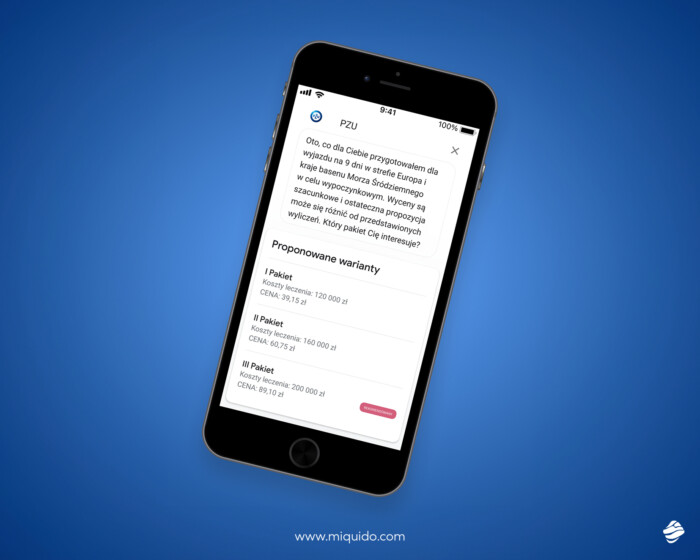
The PZU project was completed in less than six weeks! On this project, our team comprised VUI engineers, cloud professionals, developers, and data scientists.
We started with designing the flow of conversation and building the assistant’s persona. Then, the environment setup and app development were next.
We also trained the Natural Language Understanding (NLU) to assess user commands, review actions, and respond effectively.
- Social Bee
Social Bee is a German organization that helps refugees and migrants find legal employment. Their main challenge was helping these individuals navigate complex legal systems and translate important documents.
In June 2023, our team took part in Hack To The Rescue — the first Generative AI hackathon with a mission to optimize critical processes for NGOs. This was when we helped Social Bee develop an AI-based platform that translates legal documents into different languages quickly and accurately.
The platform made it easier for refugees to understand and use these documents.
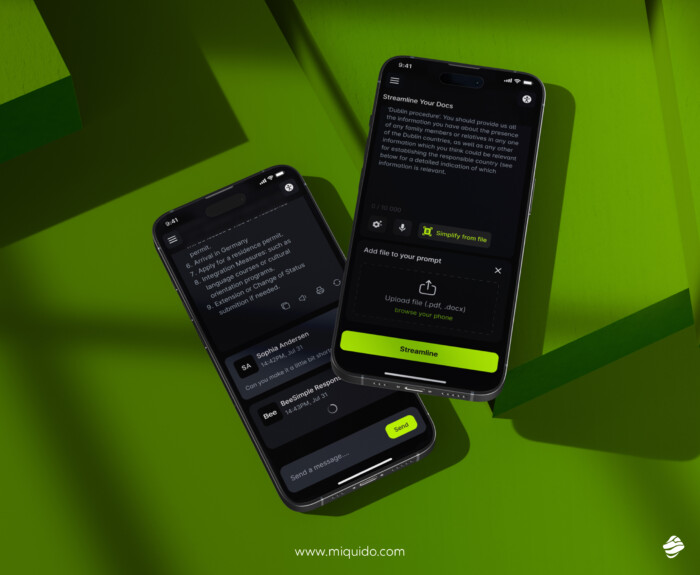
We designed Social Bee to recognize and adapt to various cultural contexts. This made it possible to deliver more accurate responses, especially for terms or concepts that could not be translated into specific words in other languages.
Overall, Social Bee’s AI tool now acts as a bridge between refugees and their assistants or law enforcement services in Germany, making documentation a lot easier.
Partnering with Miquido gives you access to the best tools and systems you need to build effective chatbots.
With over six years of experience providing AI app development services, you can rely on us to build a custom-made AI chatbot solution for your unique business needs.
- Miquibot
Miquibot is a dynamic AI chatbot powered by Chat-GPT. We designed Miquibot to help us better improve accessibility to internal resources.
Miquibot leverages advanced NLP and ML technologies to provide personalized, context-based responses to queries, making it quite effective for finding useful information.
Prior to the deployment of Miquibot, employees within our 250+ workforce struggled to get the right documents at the right time. Repeated inquiries about HR-related questions and other departments caused major productivity and time wastage issues.
After deploying Miquibot, we saw a 50% reduction in calls to the HR and IT departments about accessing information.
Our employees can use various prompts to access information from the company’s knowledge base, which typically includes technology documentation, submitted proposals, and similar resources. Here’s a visualisation of the AI architecture of Miquido’s bot.
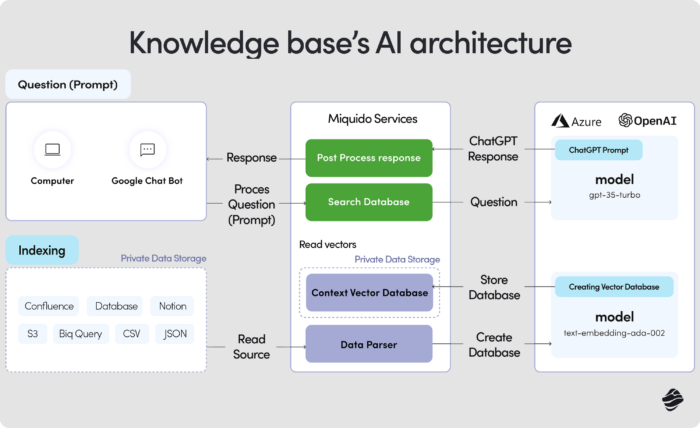
When queries are typed, Miquibot scans the company’s database and provides employees with the most accurate answers.
Miquibot can be an effective tool for businesses that aim to improve customer service and engagement, as well as internal information management. Interestingly, we developed Miquibot using our very own AI Kickstarter. The framework allowed us to implement rapid prototyping and deployment, ensuring that our chatbot could be tailored to meet specific business needs.
Future of AI chatbots
The future of AI chatbots is promising. Businesses will see more sophisticated bots capable of handling complex decision-making processes.
These bots will be key in omnichannel strategies, ensuring consistent customer experiences across platforms.
We can also expect increased use of AI chatbots in areas like human resources, supply chain management, and customer retention.
In closing
Chatbots have become an integral part of business operations, especially in creating remarkable customer experiences and helping employees work better.
The next wave of AI chatbot innovation will bring deeper integrations with advanced AI tools, more intuitive user interfaces, and greater decision-making capabilities.
Now you understand the power of AI chatbots. It’s time to make them an integral part of your business workflows.

